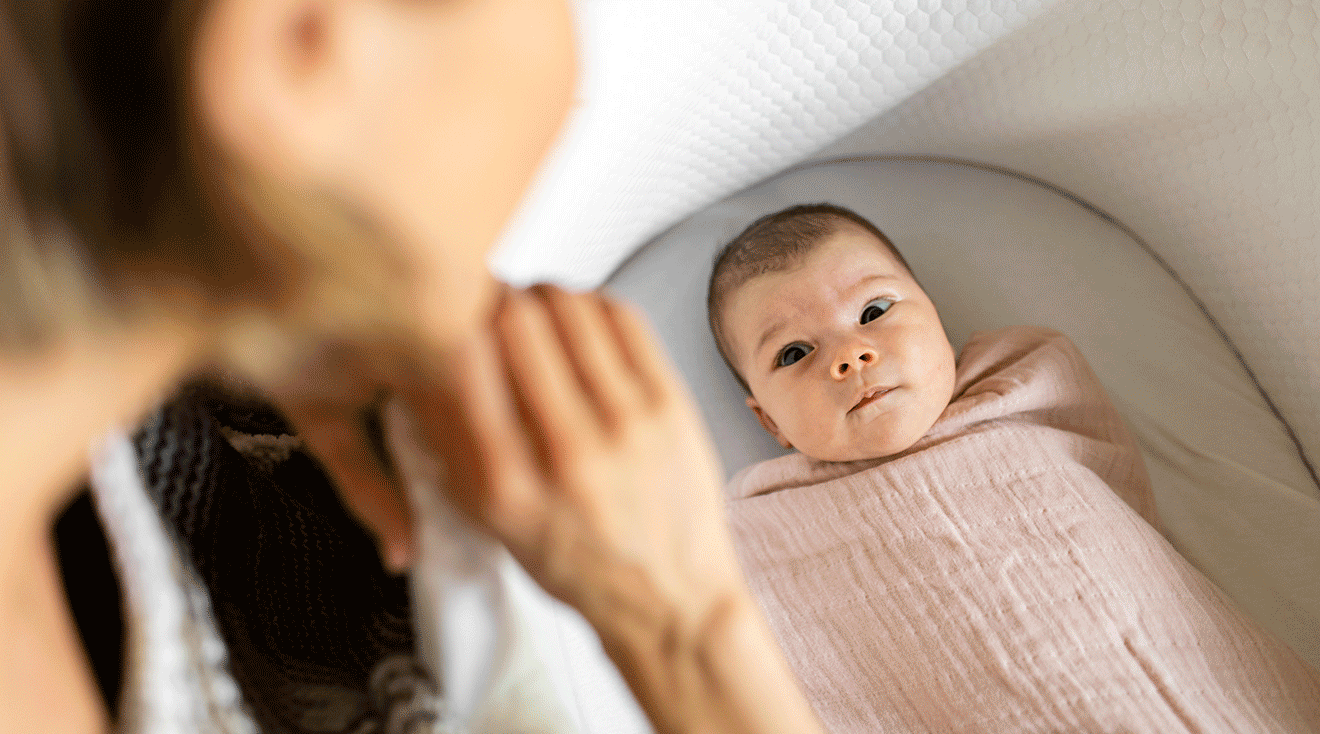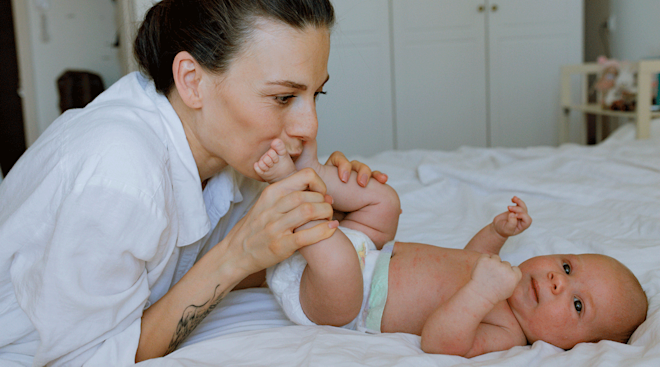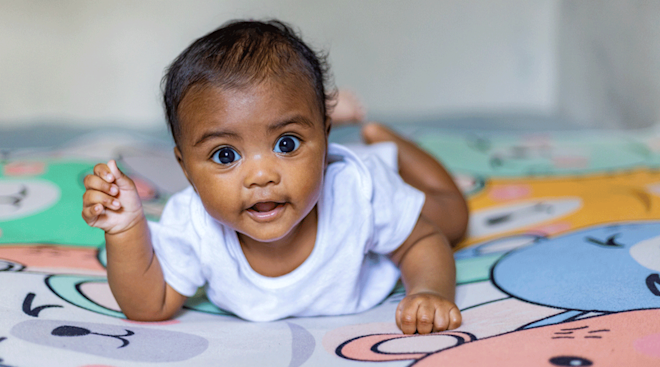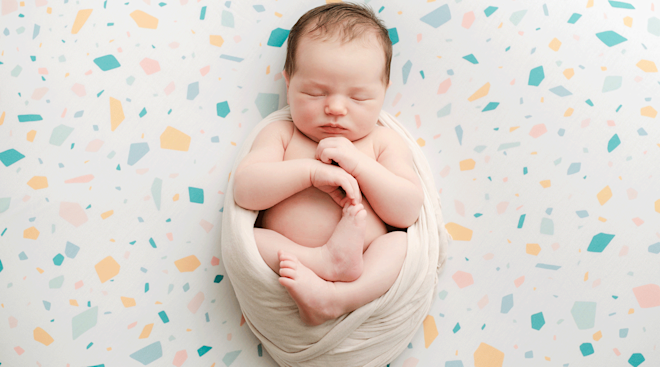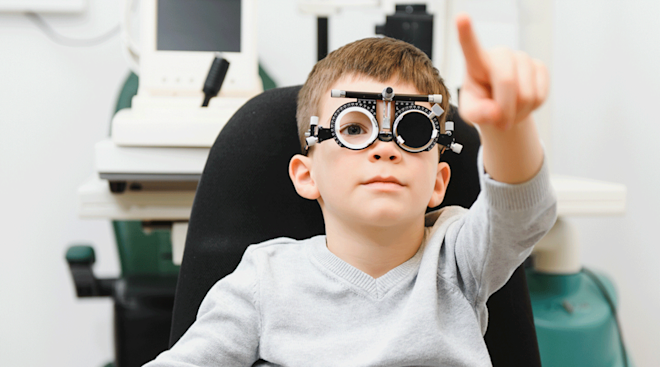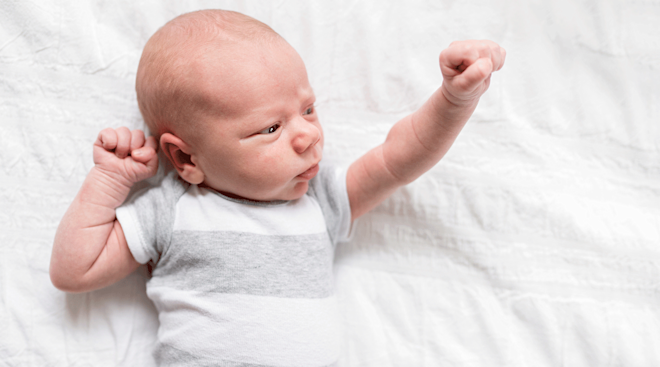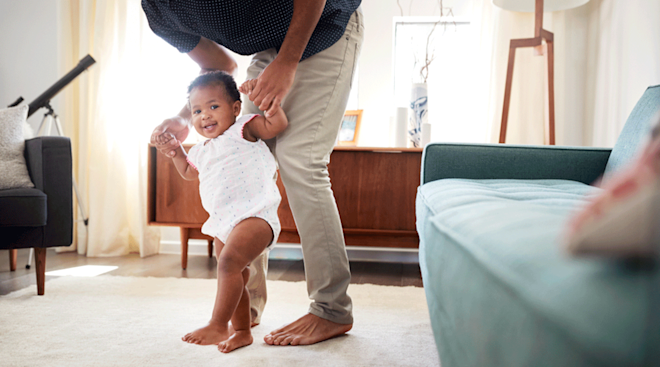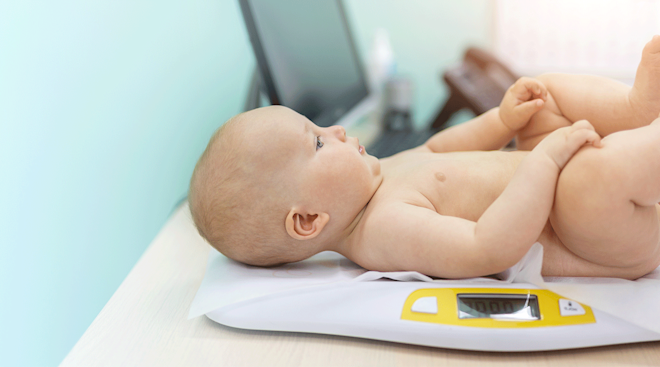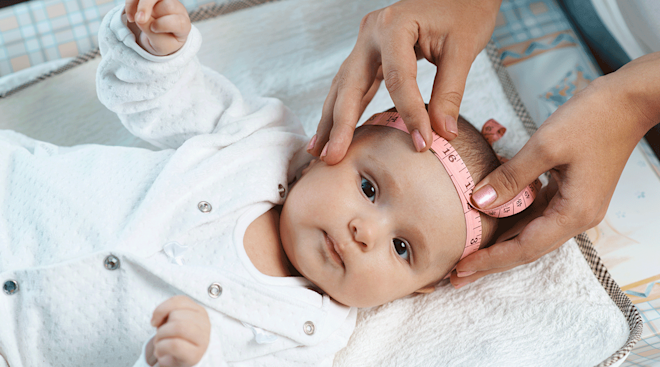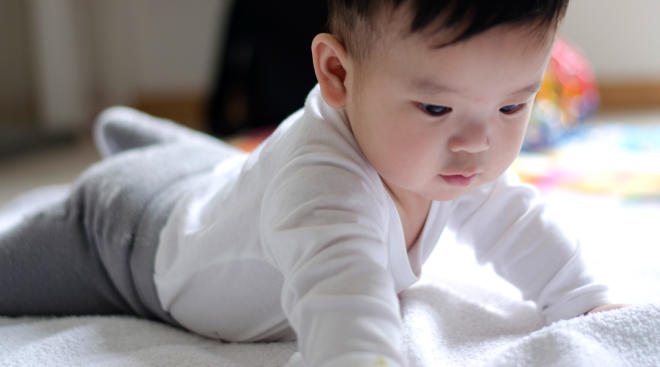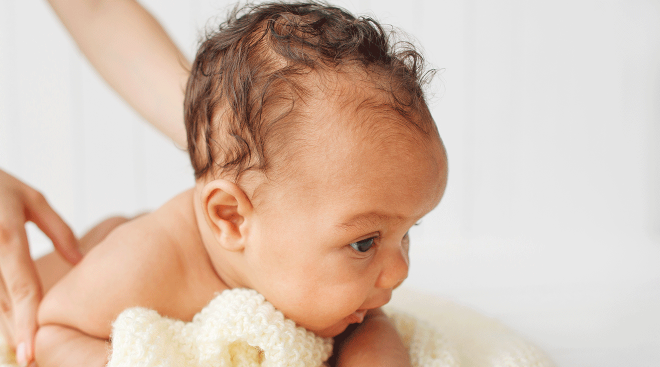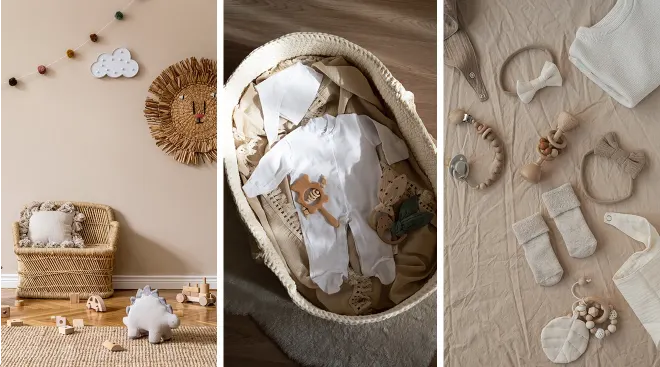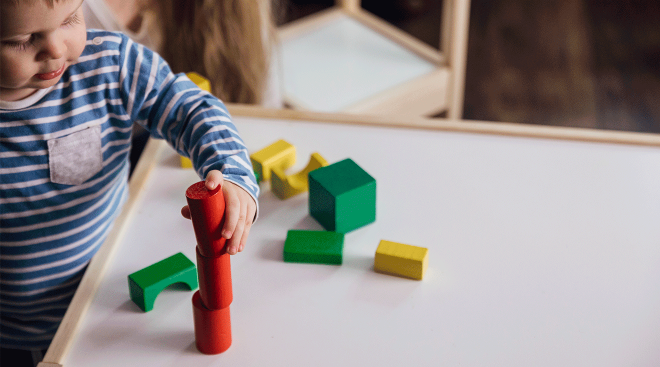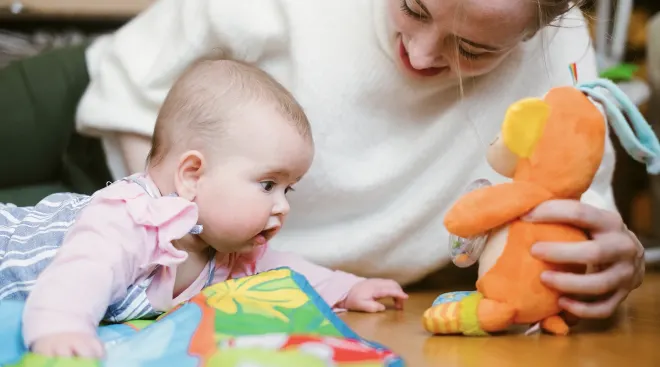When Can Babies See Clearly?
It’s thrilling to watch baby start to explore the world outside of the womb—especially as their newborn vision develops. During the first six months of life, they’ll begin to see the world in living color and with increasing depth and clarity, developing a whole new (and decidedly heart-melting!) level of curiosity. Newborn eyesight sharpens in gradual stages during the first few years of life, and as with other important aspects of growth and development, it changes and improves every day. Read on to learn how baby vision progresses over time, and when you can expect babies to see objects, faces and colors.
So how strong is newborn vision—and how far can newborns see? Basically, newborns start out seeing a blurry world. When baby is first born, their eyesight is far from 20/20—and it won’t be perfect for a good three to five years. Newborn vision starts at about 20/400, notes Kate Land, MD, a pediatrician at Kaiser Permanente. That means life will look pretty fuzzy for those first few months.
In the first week after birth and up to 3 months, baby can focus only on objects and people that are close up, around 8 to 10 inches from their face, says Denise Scott, MD, an Oklahoma-based pediatrician and author of Feed Your Child’s Future Health. "That’s about the distance between baby and the loved one holding and feeding them,” Land says. A newborn can also only hold their gaze for just a few seconds at a time and won’t yet be able to tell the difference between two different objects, adds Ron Benner, OD, president of the American Optometric Association. Moreover, don’t be alarmed if your newborn’s eyes may appear to cross or wander. "In the first few months of life, baby’s eyes can look a little crazy, like they aren’t working in a perfectly coordinated way,” says Land, who gets lots of questions about this from worried parents.
Eventually, as baby gets older, newborn vision will strengthen—they’ll be able to hold your gaze for a little longer and start to move their eyes without having to turn their head to track objects in motion. “Initially, the brain isn’t well developed enough, but by 2 to 3 months, baby should be able to fixate on an object and follow it as it moves through space,” Land says. By 3 months, they’ll start shifting their head and body to reach for those moving objects, making it a perfect time to capture baby’s attention with easy-to-grasp rattles and other sensory toys.
Ultimately, like so many other things, newborns have to work at developing their vision. “The visual part of the brain has to ‘learn’ how to see well,” says Melanie Kazlas, MD, medical director of pediatric ophthalmology and strabismus at Massachusetts Eye & Ear Infirmary in Boston. Luckily, babies start to experience various different visual stimuli right at birth that help with this, Benner adds. Plus, as baby’s vision improves, they’ll begin to focus better and at slightly farther distances—meaning instead of just zeroing in on their parents, they can see other people who are nearby too.
It’s a question that nags plenty of new parents: When can babies see fully? Every infant is unique and evolves at their own pace—and vision development may take longer for babies born prematurely, Scott notes. However, there are some general age ranges when most babies hit important baby vision milestones. Here’s what you’ll want to keep a lookout for:
Baby vision at 4 to 6 months
The world will take on a whole new hue between the four- and six-month marks, when baby is better able to see color and perceive depth. At this point, baby’s eyes should be looking in the same direction and working together to process information, Land says. Baby will gain better “control over their eye movements, and their eye-body coordination skills will continue to improve,” Benner says. Plus, he notes that baby’s vision clarity and depth perception (ability to see three-dimensionally) will also get better. By 4 months, baby’s eyes “will work together, and shouldn’t cross as frequently, Scott says, adding that their eyes should stop crossing altogether around 6 months. At this age, they’ll also be able to see as far as across a room.
Baby vision at 7 to 9 months
At this stage, baby eyesight develops even further. “Baby vision continues to sharpen in terms of visual acuity and depth as well as color,” Kazlas says. Plus, babies at this age can recognize shapes and patterns. “They’ll be able to recognize you from across a room and see much further distance,” Scott adds. This is partially due to milestones like crawling, which can occur around 8 months, Benner notes. “This helps further develop eye-hand-foot-body coordination.”
Baby vision at 10 to 12 months
Wondering when can babies see clearly? That starts to happen around this stage—in fact, at this point, babies may be able to see as well as adults. “Clinical research tells us that as babies approach their first birthday, parts of the eye and the visual part of the brain have matured, and they’ve gained enough visual experience for their vision to approach 20/20,” Kazlas says. “However, most babies aren’t yet able to tell us what they see on a standard eye chart until they’re a little older.”
Benner adds that milestones like the pincer grasp (picking up objects with the thumb and index finger) also help develop baby’s vision at this age. “Babies can also now judge distances fairly well, and they have a bit more precision when throwing things.”
Early on, baby vision is too weak to really distinguish between colors. During the newborn period, they’ll mostly see ranges of light and dark as their retinas develop (i.e. shades of white, black or gray, and possibly some bright colors), the American Academy of Ophthalmology notes. “They also tend to be light-sensitive for the first couple of months,” adds Scott. This is also why black and white and high-contrast toys are so great for young infants.
As baby’s eyesight improves in the weeks and months following birth, they’ll begin to pick up different hues—especially red and green—and will soon be able to see all colors. “In studies, babies have been shown to respond to red, green, blue and yellow starting at 3 months and up,” Kazlas says. Pastel colors may still prove tricky at this point, but baby will continue to improve their sight and, by about 5 months, will have good color vision, though not as fully developed as that of an adult, Benner says.
According to Scott, “full, clear vision is usually established by about 6 months,” and, as noted, babies can see as well as adults by around 10 to 12 months. “Eyes continue to grow through childhood,” she says. “Most young children are mildly far-sighted, but this will improve with age.” Benner notes that hand-eye coordination, as well as depth perception, is usually well developed by 2 years of age. This explains why toddlers are always on the move and so curious about exploring their surroundings!
“The presence of eye and vision problems in infants is uncommon but not rare,” Benner says. “Most babies begin with healthy eyes and start to develop the visual abilities they’ll need throughout life without difficulty.” However, it may be possible for eye health and vision problems to develop. Below, experts list some eye and baby vision problems to be aware of. Just remember, while the following are guidelines, each baby will hit milestones at their own pace. Consult your pediatrician if:
- Baby doesn’t make eye contact by around 3 months old
- They’re not tracking objects or faces with their eyes by 4 months. (This could indicate a newborn vision problem)
- Their eyes turn in or out by 6 months—especially if the frequency of occurrence increases rather than decreases with age
- Baby doesn’t reach for objects in front of them or move around objects in their way
- Eyes wander constantly (this could signify an issue with eye muscle control)
- Excessive tearing (this may signal blocked tear ducts)
- Discharge from either or both eyes or red and crusty eyelids (these could be signs of an eye infection)
- Eyes repeatedly flutter or move rhythmically (a condition called nystagmus)
- Baby tilts their head frequently when looking at things
- Baby has a white rather than red reflex in photos
- Baby’s pupils are different sizes (or if one is white)
- Extreme sensitivity to light (could indicate increased eye pressure)
- Frequent rubbing of one or both eyes
- Baby’s eyes stay fixed in a crossed or deviated position for a long period of time
“The appearance of any of these signs require immediate attention by a doctor of optometry for a complete look at their eyes,” Benner says. “Eye health problems are not common, but if present, early detection and treatment offer the best future for your little one.” During the eye exam, they’ll test for many things, including nearsightedness, farsightedness, astigmatism, any amblyogenic factors that limit the eyes ability to develop and learn to see clearly including eye movement ability and eye alignment, he adds.
According to the experts, there’s plenty that parents can do to help support newborn and baby vision development. To help develop newborn vision, Benner recommends using a nightlight or other dim lamp in baby’s room, talking to baby, keeping objects 8 to 12 inches from them and switching sides with each feeding. Offering baby developmentally appropriate toys is also key. For newborns, this means high-contrast and brightly colored objects. For older infants—to help with depth perception—Scott suggests blocks, containers and playing peek-a-boo using a mirror. Benner also recommends using crib mobiles and play gyms, and engaging in games like patty cake. “Give baby plenty of time to play and explore on the floor…encourage crawling and creeping,” he says, Even if baby’s eyesight isn’t functioning at full capacity, it’s important for them to keep practicing. “A saying I like to use with parents is: 'If a baby doesn’t use their vision, they’ll lose their vision,’” Kazlas says. “Having a proper visual experience is critical [from the start.] Any impediments to getting a clear, focused image to the brain will cause a loss of vision in a child, a condition called amblyopia.”
Along with providing lots of visual stimuli, make sure to protect baby’s eyes when outside with sun hats, sunglasses and sun shades. Experts also recommend keeping up with regular pediatrician and optometrist checkups. “Vision screening tests, done either by the nurse or with a vision screening device, are helpful to pick up potentially serious vision problems in a child, but a complete eye exam by a pediatric ophthalmologist is the gold standard,” Kazlas says.
When do babies open their eyes?
According to Benner, most babies open their eyes and start to see within 20 minutes of being born. Another interesting fact? At birth, baby’s eyes are about 65 percent of their adult size, says Scott. To make sure baby’s eyes are in good shape and that their reflexes are functioning, they’ll have their first eye exam in the delivery room or nursery the day they’re born. Your pediatrician will continue to examine and monitor baby’s eyesight at each well visit.
When can babies see faces?
Because they can see around 10 inches away from birth, babies can see faces early on in the newborn period, Scott says—but they’ll look blurry. “They usually will look to the edge of your face, where there is contrast rather than in your eyes,” she explains. “By 6 to 8 weeks, they’ll begin to look you in the eyes but only briefly.”
Please note: The Bump and the materials and information it contains are not intended to, and do not constitute, medical or other health advice or diagnosis and should not be used as such. You should always consult with a qualified physician or health professional about your specific circumstances.
Plus, more from The Bump:
Ron Benner, OD, is the president of the American Optometric Association and a private-practice optometrist in Laurel, Montana. He earned his degree from Pacific University College of Optometry.
Melanie Kazlas, MD, is the medical director of pediatric ophthalmology and strabismus at Massachusetts Eye & Ear Infirmary in Boston. She also serves as an assistant professor of ophthalmology at Harvard Medical School. She earned her medical degree from Albany Medical College and completed her residency at New York University School of Medicine.
Kate Land, MD, is a pediatrician at Kaiser Permanente. She earned her medical degree from and completed her pediatrics residency at the University of California, Davis.
Denise Scott, MD, is a pediatrician and a pediatric endocrinologist based in Oklahoma with over 30 years of experience. Certified in culinary medicine, Scott also runs the blog Feed Future Health and is the author of Feed Your Child’s Future Health: Prevent Disease Before It Starts. She received her medical degree from the University of Texas Medical Branch and completed her residency at the University of Oklahoma Health Sciences Center with a fellowship at the National Institutes of Health.
American Academy of Ophthalmology, Vision Development: Newborn to 12 Months, February 2022
Learn how we ensure the accuracy of our content through our editorial and medical review process.
Navigate forward to interact with the calendar and select a date. Press the question mark key to get the keyboard shortcuts for changing dates.
































